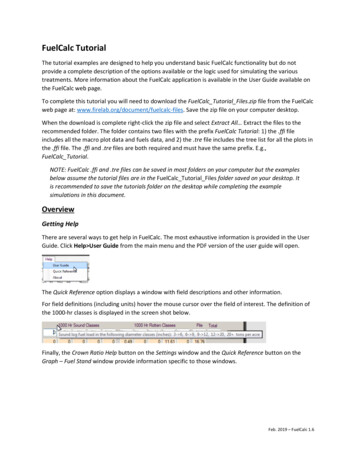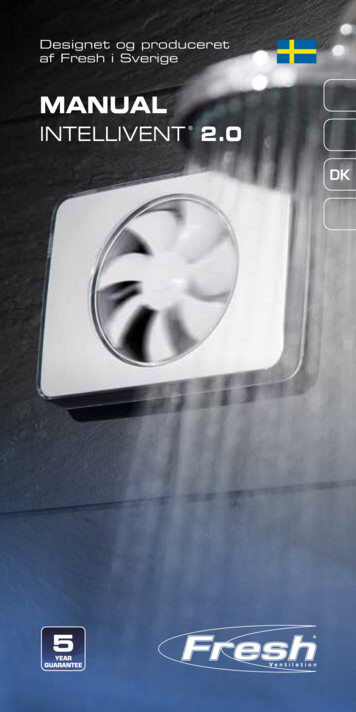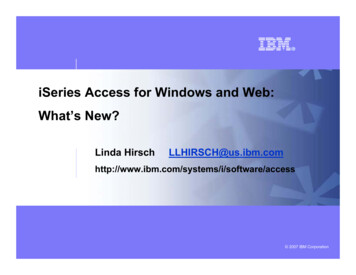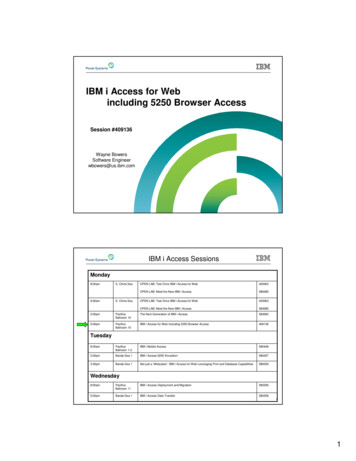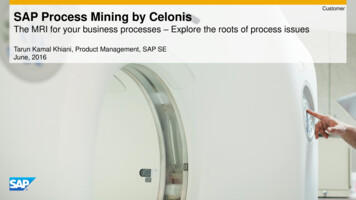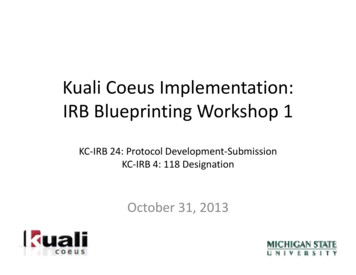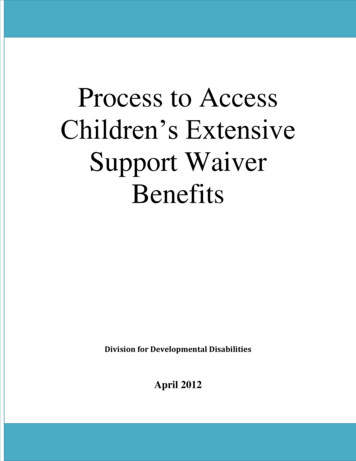
Transcription
Process to AccessChildren’s ExtensiveSupport WaiverBenefitsDivision for Developmental DisabilitiesApril 2012Division for Developmental DisabilitiesJune 20111
Appreciation is given to the following individuals for theircontribution of time and knowledge.Shilo Carson, Developmental PathwaysLauren Ryon, Developmental PathwaysRachelle Stoddard, Developmental PathwaysCorinne Lipski, Developmental Disabilities Resource CenterDiana Patty, Developmental Disabilities Resource CenterAnne McNally, Denver OptionsPat Carney, Foothills GatewayLisa Thomason, Community OptionsNancy Fritchell, Division for Developmental DisabilitiesSheila Peil, Division for Developmental Disabilities
IndexOverview of Process . 1EPSDT. 2Adapted Therapeutic Recreational Equipment and Fees . 6Assistive Technology . 10Behavioral Services. 15Community Connector . 20Home Accessibility Adaptations. 23Homemaker . 31Parent Education . 34Personal Care . 37Professional Services . 41Respite . 45Specialized Medical Equipment and Supplies . 50Vehicle Modifications . 53Vision . 57
Appendix A: Letter of Medical Necessity Template . 59Appendix B: Professional Recommendation Guideline/Template . 61Appendix C: Assistive Technology/Vehicle Modification Template . 63Appendix D: Home Accessibility Adaptations Bid Template . 64Appendix E: Frequently Requested Items List . 66
Process to Access Services OverviewThis technical assistance document will provide guidance in accessing benefits that are availablethrough the Children’s Extensive Support (CES) Waiver and assist in navigating the fundinghierarchy to be utilized prior to accessing CES.All services and supports an individual may need are not covered in this document. The waiver isnot intended to provide 24-hour care and must be considered as part of the overall supportsystem for an individual. The individual’s total Service Plan will include waiver services as wellas a variety of services or supports from other resources. Although many potential fundingsources are identified, these sources may change over time and it is the responsibility of theCommunity Centered Board to assure each funding source is correctly utilized. Continued andongoing update to the Medicaid Provider Manuals can be found at:https://www.colorado.gov/hcpf/provider-newsThe provider bulletin specific to durable medical equipment, prosthetics, orthotics and suppliescan be found at the link above, or via the direct link for this wsThere is a funding hierarchy that must be applied before accessing services through the waiver.The funding hierarchy will be applied in this order:A. Natural Supports and Third Party Resources: The first consideration of funding will beNatural Supports and Third Party Resources.1. Family Resources; Family resources should be explored as a funding option for low costitems.2. Insurance; In the instance the family has insurance that will cover the service it must beutilized prior to Medicaid or waiver sources.3. Trusts; Use of a trust may depend upon the conditions under which the trust wasestablished.4. General Community Resources; Such as educational systems, lending libraries orclosets, City, County, Civic, Religious or disability/syndrome specific benefitorganizations may be available.B. Medicaid State Plan: The Department of Health Care Policy and Financing publishes aprovider manual each year along with provider updates listing services available throughMedicaid State Plan. Current updates to the manual and bulletins can be found at this link:https://www.colorado.gov/hcpf/provider-news Supports/services or items available throughMedicaid State Plan will not be reimbursed through the waiver unless it can be demonstratedthat the requested support/service or item is not available through Medicaid following appealand final agency action. Service providers are responsible for obtaining prior authorizationfor services. If the provider is reluctant to submit a claim that the provider believes will bedenied, refer to Appendix E to see if the item is a common item that does not require aMedicaid denial prior to accessing HCBS-CES. If it does require a Medicaid denial and theprovider will not submit a claim please contact the appropriate waiver coordinator.Division for Developmental DisabilitiesJune 20111
C. Early and Periodic Screening Diagnosis and Treatment (EPSDT): Any child enrolled inMedicaid ages birth through 20 is eligible for EPSDT. Each service area has an EPSDTOutreach Coordinator who will inform families about their EPSDT benefits, educate onpreventive health care, assist in selecting primary care providers, assist in accessing healthcare providers, assist in accessing health care services, dental appointments or non-emergentmedical transportation if needed, verify appointments and assist in identifying the names andlocations of health care providers. Contact information for coordinators can be found at epsdt1. EPSDT provides medically necessary services to any child eligible for EPSDT.2. HCPF Rules 8.280.1 DEFINITIONS: Medical necessity means that a covered serviceshall be deemed a medical necessity or medically necessary if, in a manner consistentwith accepted standards of medical practice, it:a. Is found to be an equally effective treatment among other less conservative or morecostly treatment options, andb. Meets at least one of the following criteria:i) The service will, or is reasonably expected to prevent or diagnose the onset of anillness, condition, primary disability, or secondary disability.ii) The service will, or is reasonably expected to cure, correct, reduce or amelioratethe physical, mental cognitive or developmental effects of an illness, injury ordisability.iii) The service will, or is reasonably expected to reduce or ameliorate the pain orsuffering caused by an illness, injury or disability.iv) The service will, or is reasonably expected to assist the individual to achieve ormaintain maximum functional capacity in performing Activities of Daily Living.Medical necessity may also be a course of treatment that includes mere observation or notreatment at all.3. EPSDT Benefits include (but not limited to):a. Assistive Technologyb. Augmentative Communication assessment and equipmentc. Bath equipment such as rails, a shower chair or benchd. Behavior reviewe. Braces for the teeth or Orthodontia ONLY for severe handicapping malocclusionsf. Care out of the State of Colorado (ONLY if an appropriate provider is not available inthe state)g. Developmental evaluationh. Dental care, including fillingsi. Diagnostic services such as EKGj. Disposable supplies such as diapers (starting at age 4), syringes and cathetersk. Durable Medical Equipment (DME) such as walkers, wheel chairs and medicallynecessary car seatsl. Emergency room for life threatening or emergent situations.m. Extended care facilitiesn. Feeding supplies such as G-tube, J-tube, NG-tubesDivision for Developmental DisabilitiesApril 20122
o.p.q.r.s.t.u.v.w.Hearing tests and treatments including hearing aids and batteriesHospital beds, bed rails, and pressure padsHospitalizationImmunizationsLab tests such as blood, skin, or urine and pap smearsMedical Transportation*Mental Health servicesOrthotics such as braces and splintsOxygen and oxygen equipment such as nebulizers, respirators or ventilators andsuppliesx. Physician services including specialisty. Prescription drugs** (usually generic) NOT including most over-the-countermedicationsz. Prosthetics such as glass eyes and artificial limbsaa. Radiology services such as x-raysbb. Rehabilitation facility carecc. Skilled nursing services and therapiesdd. Suctioning equipmentee. Surgeriesff. Therapies such as Occupational (OT), Physical (PT) and Speech Therapy (ST)gg. Tracheotomy and laryngectomy equipment and supplieshh. Vision exams and treatment including eyeglassesii. Well child screening visits (EPSDT screens)jj. Sick care visitskk. Wheelchairs (manual, electric, and specialty), accessories and repairs**Transportation is not available to and from school.** When filled under a prescription, many over-the-counter items may be available for coverage followingan approved prior authorization for medical necessity. The products which are allowed for coverage underprior authorization must be eligible for rebate under the National Drug Rebate Program. For moreinformation, please reference the CMS website under the “rebate drug product data file”. Families in aHealth Management Organization should check with their HMO.4. In the event the child needs a service/item that Medicaid has denied but it is “Medicallynecessary” the family has 30 days from the date of the denial letter to file an appeal.(HCPF Rule; 8.057.4.B. 1.)5. In some instances, a Prior Authorization Request (PAR) will need to be completed beforethe service/item is approved. In both instances a “Letter of Medical Necessity” will needto be completed. See Appendix A for an example of the “Letter of Medical Necessity”.The letter must contain:a. Patient’s name and Medicaid identification numberb. Date of Birthc. All related diagnosesd. Description of the medical need for the item (this could also include behavioral needfor the item)Division for Developmental DisabilitiesApril 20123
e. Demonstration of cost effectiveness. Letter must show how the needed service oritem will result in cost savings to the waiver.f. List of services or items that have been previously utilized and reasons why theservice or item was not effectiveg. Likely impacts if this item or service is not approvedh. Demonstration of how this is related to health and safetyItems available through Medicaid/EPSDT will not be provided through the waiver. In someinstances a Medicaid denial following final agency action will be required to verify the support isnot available prior to accessing the waiver. This means the family must appeal the denial andcomplete the process through final agency action.Note: some items/services may require a PAR along with a Letter of Medical Necessity (Seepage 59 for Letter of Medical Necessity Template)References:EPSDT Web site:http://www.colorado.gov/cs/Satellite?c Page&cid 1218622604254&pagename ate.co.us/CCR/Rule.do?deptID 7&deptName cy%20and%20Financing&agencyID 69&agencyName 2505%20Medical%20Services%20Boar&ccrDocID 2919&ccrDocName 0%20SECTION%208.200&subDocID 35234&subDocName ersion 7D. Children’s Extensive Support (CES) provides benefits to eligible children based onassessed need. The goal of the CES waiver is to provide supports to the child in the familyhome to avoid out of home placement. This does not replace typical parental responsibilitybut enhances and supports the care provided by parents.1. Services and supports are to be provided in an “age appropriate manner”. Thisspecifically means that the service and support must be due to the child’s disability andnot due to the child’s age.2. Services and supports are to be related to the child’s disability.3. Items that are typical for all children are parent responsibility and shall not be providedthrough CES. Examples of these items include, but are not limited to, typical recreationaltoys, games, videos, CDs and DVDs.4. Waiver supports and services are to be provided in the most cost effective manner.Consideration of cost effective should include quality of the product, durability andappropriateness.Division for Developmental DisabilitiesApril 20124
5. Payment for CES services/supports may only be made to approved providers;payment/reimbursement may not be made to the parents.6. Services and supports are not to be duplicative of services and supports availablethrough Medicaid/EPSDT.7. Services and supports are to be selected among commonly accepted practices andshall not be experimental.CES Benefit descriptions are described in detail and grouped according to available CESservices beginning on page 6. Although there are some redundancies between descriptions ofeach service to allow for independent use of each section it should be noted that each servicedescription contains specific information and should be thoroughly reviewed prior to approval ofthe service.Templates for Assessments and Bids beginning on Page 61 are optional.Beginning on Page 66 there is a list of Frequently Requested Items. This list will assist inaccessing funding sources for services and supports.Division for Developmental DisabilitiesApril 20125
Adaptive Therapeutic Recreational Equipment and FeesAdaptive Therapeutic Recreational Equipment; T1999; Modifier U7 (1 unit 1.00)Recreation Fees to Access Professional Services; S5199; Modifier U7 (1 unit 1.00)Frequently Requested Items; Page 68Adaptive Therapeutic Recreational Equipment and Fees may be used only in one of three ways:1. The child needs a recreational item that is specifically adapted for the child's disability.Typical recreation items are not to be provided through CES. This specifically means; ifthere is no adaptation to the item, CES cannot pay for it.2. Fees for entrance to a recreation center ONLY if the child needs to enter in order toaccess a service that is habilitative in nature, such as Physical Therapy, OccupationalTherapy or professional services as defined in the waiver or to achieve or maintain aspecific therapy goal as recommended and supervised by a doctor or therapist. Forexample, if the child is receiving Massage therapy in a warm water pool in a recreationcenter where an entry fee is required, and there are no other resources available toprovide the fee, the waiver may be accessed.3. Water Safety trainingThis service category is not to be utilized for camp, recreational outings or any activities otherthan those described within the service description. This service category also contains a hardcap of 1,000 units per plan year.HCPF Rule 8.503Adaptive therapeutic recreational equipment and fees are services which assist a client torecreate within the client’s community. These services include recreational equipment that isadapted specific to the client’s disability and not those items that a typical age peer wouldcommonly need as a recreation item.The cost of item shall be above and beyond what is typically expected for recreation andrecommended by a doctor or therapist.Adaptive recreational equipment may include adaptive bicycle, adaptive stroller, adaptive toys,floatation collar for swimming, various types of balls with internal auditory devices and othertypes of equipment appropriate for the recreational needs of a client with a developmentaldisability.A pass for admission to recreation centers for the client only when the pass is needed to access aprofessional service or to achieve or maintain a specific therapy goal as recommended andsupervised by a doctor or therapist. Recreation passes shall be purchased as day passes ormonthly passes, whichever is the most cost effective.Adaptive therapeutic recreation fees include those for water safety training.Division for Developmental DisabilitiesApril 20126
LimitsThe maximum annual allowance for Adaptive Therapeutic Recreational Equipment and Fees is1,000.00 units per service plan year (1 unit 1.00).ExclusionsThe following items are specifically excluded under HCBS-CES and not eligible forreimbursement:Entrance fees for zoos, museums, butterfly pavilion, movie, theater, concerts,professional and minor league sporting events, outdoors play structures, batteries forrecreational items; and passes for family admission to recreation centersThresholdsCCB CM level: Equipment: 0-1,000; Fees: NACCB Supervisor level: Equipment: NA; Fees: NADDD level: Equipment: NA; Fees: AllProvider QualificationsVendor: The provider shall have all licensures required by the State of Colorado for theperformance of the service or support being provided.Key Considerations1. Will an assessment be needed?a. Can the child utilize the adapted recreational item the family is requesting?2. Is the item adapted in a disability specific manner?a. Items must be adapted, typical recreational items (toys) are not allowed.3. How is the expense above and beyond the typical expense?4. What would be the typical parent expense?a. Recreation items: The cost of a typical item versus the cost of an adapted itemb. Parent shall pay the typical cost; the waiver may pay additional cost5. Have alternative funding sources been explored?a. Recreation centers often have scholarships or reduced fee based on family incomeb. Lending closets, loan of item civic organizations, medical insurance, etc.6. Fees to access Medicaid State Plan or CES Professional servicesa.Are the services documented in the service plan?7. Are the recreational fees only for the child?8. Water Safetya. Does the child have access to water in everyday life where water safety trainingwould be necessary?b. As “Water Safety” training requested due to the desire for typical swim lessons ordesire to recreate in the water?c. What would be the typical parent expense for swim lessons?9. Is the support specifically excluded?Process to AccessDivision for Developmental DisabilitiesApril 20127
Support options should come from many different sources in a community and should not focusonly on services provided through CES. Families, communities, Community Centered Boards(CCBs) and others should work together to encourage creative and individualized responses foridentified needs. A combination of generic community resources, natural supports, and othertypes of supports help offer flexibility and choices, which are not solely reliant on a long-termsystem of paid support for the child. By utilizing a wide array of community-based supportoptions, the family, CCB and the community can address the immediate and future needs of thechild. This may reduce or avoid more costly supports later.If the Inter-Disciplinary Team (IDT) determines the identified need fits within this servicedefinition, the funding hierarchy will be:A. Natural Supports and third party resources: The Case Manager (CM) and familydetermine if Natural Supports and third party resources are available to meet the need.Natural supports can include family resources, insurance, trusts, educational/school system,disability-specific foundations, as well as general community resources such as city, county,civic or religious organizations. CM documents natural supports availability in the ServicePlan (SP). Recreation centers often have scholarships or reduced fee based on family income.B. Medicaid/EPSDT does not provide Therapeutic Recreational Activities and Fees.C. Children’s Extensive Support Waiver1. If applicable obtain a recommendation/assessment from the appropriate MedicaidPhysician or Therapist (e.g. Primary Physician, Psychiatrist, Occupational, Physical,Speech or Behavioral Therapists). The recommendation will give a general overview ofthe status of the client including age, diagnoses and current functioning level. Thespecific adaptive recreational item that relates to the disability will be identified alongwith a brief description of why a typical recreational item cannot be used. If a specificitem brand is required that increases the cost over the basic adaptation, the therapist mustprovide justification for the additional cost. If the need for this service is for RecreationCenter Fees the specific service the child is accessing must be identified. Retainrecommendation for documentation purposes. (See Appendix B - Page 61; ProfessionalRecommendation Guideline/Template)2. Once the recommendation is complete, review to assure it contains the requiredcomponents. If further information is needed, contact the recommending provider.3. Request estimates/bids from vendors for items. Estimates must clearly indicate thecompany name, address and phone number and any required payment information (mayvary by CCB). Items will be detailed with product description and cost. Therecommending professional, family or CCB may obtain the estimates. If an estimateappears too high/low, additional estimates from alternative sources may be requested forcomparison.4. Review to approve/deny estimate per local CCB procedure.5. Select vendor or provider following local CCB procedures.6. Complete the IPCSDivision for Developmental DisabilitiesApril 20128
a. If the request is above the CCB threshold for review submit the IPCS for State LevelReview. Once the IPCS is accepted through the PAR process, the service/item may beadded to the Service Plan (SP).b. If the request is below the CCB threshold for review; following internal CCBapproval submit the IPCS through the PAR process and update the SP.7. The Service Plan must be accepted through CCMS prior to item purchase or serviceprovision.a. The need for Adaptive Therapeutic Recreational Equipment and Fees must bedocumented in the current SP. The SP will list the items/service, providers andnumber of units (1 unit 1.00). The SP plan should clearly indicate the type, scope,amount and frequency of services to be delivered.b. Authorized services will be provided according to the SP timeframes. If the hours areallocated in the SP plan on a weekly or monthly basis unused units from one monthwill not be available for following months. (I.e. Units may not be saved up and usedin amounts other than identified in the SP.)c. Service claims in excess of PAR amounts will not be paid by the State.d. Any increase in services must be documented in an SP revision and authorizedthrough the prior authorization process.8. Once the PAR is completed and accepted items may be purchased.Division for Developmental DisabilitiesApril 20129
Assistive TechnologyT2035; Modifier U7 (1 unit 1.00)Frequently Requested Items; Page 69Most items within this category are available through Medicaid/EPSDT.HCPF Rule 8.503Assistive technology includes services, supports and/or devices that assist a client to increase,maintain or improve functional capabilities. This may include assisting the client in the selection,acquisition, or use of an assistive technology device and includes:The evaluation of the assistive technology needs of a client, including a functionalevaluation of the impact of the provision of appropriate assistive technology andappropriate services to the client in the customary environment of the client,Services consisting of selecting, designing, fitting, customizing, adapting, applying,maintaining, repairing, or replacing assistive technology devices,Training or technical assistance for the client, or where appropriate, the family members,guardians, care-givers, advocates, or authorized representatives of the client,Warranties, repairs or maintenance on assistive technology devices purchased through theHCBS-CES waiver, andSkill acquisition devices which are proven to be a cost effective and efficient means tomeet the need and which make learning easier, such as adaptations to computers, orcomputer software related to the client’s disability. This specifically excludes cellphones, pagers, and internet access unless prior authorized by the in accordance with theoperating agency’s procedures.Assistive technology devices and services are only available when the cost is higher than typicalexpenses, and are limited to the most cost effective and efficient means to meet the need and arenot available through the Medicaid state plan or third party resource.Assistive technology recommendations shall be based on an assessment provided by a qualifiedprovider within the provider’s scope of practice.When the expected cost is to exceed 2,500 per device three estimates shall be obtained andmaintained in the case record.Training and technical assistance shall be time limited, goal specific and outcome focused.LimitsThe total cost of home accessibility adaptations, vehicle modifications, and assistive technologyshall not exceed 10,000 over the five (5) year life of the HCBS-CES waiver without anDivision for Developmental Disabilities10April 2012
exception granted by the operating agency. Costs that exceed this limitation may be approved forservices, items or devices to ensure the health and safety of the client or that enable the client tofunction with greater independence in the home, and/or decrease the need for paid assistance inanother HCBS-CES waiver service on a long-term basis. Requests for an exception shall be priorauthorized in accordance with the operating agency’s procedures. The operating agency shallrespond to exception requests within thirty (30) days of receipt.ExclusionsThe following items and services are specifically excluded under HCBS-CES and not eligible forreimbursement:Purchase, training or maintenance of service animals,Computers,In home installed video monitoring equipment,Medication reminders,Hearing aids,Items or devices that are generally considered to be entertainment in nature including but notlimited to CDs, DVDs, i-Tunes , any type of games ,Training, or adaptation directly related to a school or home educational goal or curriculum;orItems considered as typical toys for children.ThresholdsCCB may authorize amounts below 10,000 for a combined total of Assistive Technology,Home Accessibility Adaptations and Vehicle Modifications.State level review required for prior authorization on any combined total above 10,000.It is the CCB’s responsibility to track spending in these three categories and request approval toexceed the total.Provider QualificationsThe product or service to be delivered shall meet all applicable manufacturer specifications, stateand local building codes, and Uniform Federal Accessibility Standards. The provider shall haveall certifications and or licensures required by the State of Colorado for the performance of theservice or support being provided.Key Considerations1. Has an assessment been completed by a qualified therapist within his or her scope ofpractice?2. Does the identified support increase, maintain or improve the child’s functionalcapabilities (activities of daily living)?a. Are the needs clearly identified in the ULTC 100.2 assessment?b. If the service or support specifically assists the individual achieve or maintainActivities of Daily Living (ADLs) or is medically necessary a request shall besubmitted to Medicaid/ESPDT. If the service or support is denied through Medicaid,then the waiver may be considered following final agency action.Process to AccessDivision for Developmental DisabilitiesApril 201211
Support options should come from many different sources in a community and should not focusonly on services provided through CES. Families, communities, Community Centered Boards(CCBs) and others should work together to encourage creative and individualized responses foridentified needs. A combination of generic community resources, natural supports, and othertypes of supports help offer flexibility and choices, which are not solely reliant on a long-termsystem of paid support for the child. By utilizing a wide array of community-based supportoptions, the family, CCB and the community can address the immediate and future needs of thechild. This may reduce or avoid more costly supports later.If the Inter-Disciplinary Team (IDT) determines the identified need fits within this servicedefinition, the funding hierarchy will be:A. Natural Supports and Third Party Resources: The Case Manager (CM) and familydetermine if Natural Supports and third party resources are available to meet the need.Natural supports can include family resources, insurance, trusts, educational/school system,disability-specific foundations, as well as general community resources such as city, county,civic or religious organizations. CM documents natural supports availability in the ServicePlan (SP).B. Medicaid/EPSDT: Some items for Assistive Technology may be available underMedicaid/EPSDT; which may or may not require a Prior Authorization Request throughHCPF. (See Appendix E- Page 66; Frequently Requested Items)C. Children’s Extensive Support Waiver1. If applicable, obtain a recommendation/assessment from the appropriate Medicaidapproved provider (e.g
2. HCPF Rules 8.280.1 DEFINITIONS: Medical necessity means that a covered service shall be deemed a medical necessity or medically necessary if, in a manner consistent with accepted standards of medical practice, it: a. Is found to be an equally effective treatment among other less conservative or more costly treatment options, and b.
